CoalConnect - Machine Guided Construction
With 42 machine guidance systems, CoalConnect was the largest machine control earthmoving project in the Southern Hemisphere. This paper details the extensive preparations that ensured a successful machine guided construction site.
Published: 30 August 2012
Author: Steed Shepherd - Machine Control / Data Manager, CoalConnect
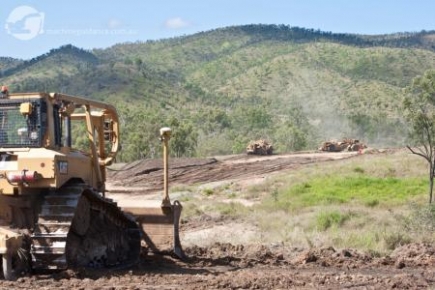
Executive Summary
With 42 construction plant equipped with 3D-guidance at the peak of construction, the CoalConnect project alliance was the largest machine control earthmoving project in the Southern Hemisphere.
All this machine control didn't just happen by accident; it required significant forethought and preparation. Before construction commenced, the CoalConnect survey team monitored over 800 control marks to confirm the accuracy of a single suitable coordinate framework that could be utilised over the entire 167.4 km project footprint.
A permanent GPS correction delivery system was established across the entire CoalConnect site to ensure a reliable and consistent positioning network that could be instantly accessed anywhere on the project footprint. Design models that were purpose-built for earthworks operations were also created and synchronised to ensure consistency across all field devices.
This preparation allowed the earthworks operations to fully utilise the advantages of machine control products when construction began. All bulk earthworks fleets included machinery equipped with 3D design referencing solutions so that traditional earthworks survey set-out was not required.
By providing earthworks fleets with immediate access to design reference without the delay of waiting for survey set-out, construction progress was fast-tracked. The advantages of this immediate access became even more evident when after significant weather events, construction programming was able to be further accelerated by increasing the number of machine-control plant.
There is no doubt that CoalConnect benefited from reduced earthworks survey requirements due to the using machine control technologies. Employing machine guidance over traditional construction methods provided CoalConnect with additional benefits including an increase in worksite safety, improved construction accuracy, faster design model updates, more efficient reactions to unplanned works and increased job satisfaction for construction field crews.
The extensive and successful use of machine guided construction over traditional construction methods helped ensure the success of the project. Despite some significant weather events that included two cyclones and severe flooding, CoalConnect delivered all works on-time and on-budget.

Project Background
The CoalConnect project alliance, comprised of QR National, Leighton Contractors, GHD and KBR, delivered civil works to QR National's $AU1.1 billion Goonyella to Abbot Point (GAP) Expansion Project in the Bowen Basin, Queensland. At construction, the GAP Expansion Project was one of the largest investments ever made in rail infrastructure in Australia and by mid-2012 it doubled coal transport capacity to the Port of Abbot Point.
CoalConnect, with its numerous subcontractors, delivered civil works that spanned 167.4 km from the North Goonyella Mine in the south through to Bogie River in the north. Valued at $AU373 million, CoalConnect's scope included the 69 km Northern Missing Link (NML). The NML rail line built through a greenfield site connected the Goonyella and Newlands coal rail systems. The CoalConnect scope also included significant upgrades to the existing Newlands rail line including a 14 km duplication at Briaba (from 5 km north of Collinsville) and a 2 km passing loop at Cockool (32 km south of Collinsville).
In total, CoalConnect completed over 85 km of railway formation, 15 level crossings, six road intersections, 11 railway bridges, two road-over-rail bridges and over 175 drainage culverts. The project team moved 3.16 million m3 of bulk earthworks and placed approximately 500,000 t of final layer capping material.

Survey Preparation
Survey Preparation (1)
From project commencement, it was the survey team's determination that the entire CoalConnect site be established holistically, working from the whole to the part. When creating survey coordinate and control networks, this principle is always important but it is increasingly vital when dealing with complex positioning techniques across significant distances. Establishing a holistic framework for the entire construction footprint was crucial in controlling the accumulation of errors that can occur when concentrating on smaller areas and then attempting to hatch them all together.
This concept is often in conflict with general construction programming. It was the survey team's intent to commence positioning determinations prior to construction commencement. However, when earthworks foreman and engineers see dirt they want to move it - now! Convincing the construction team of the importance of locking down the finer points of the design position prior to earthworks commencing was a challenge.
Complicating this challenge, plans to mobilise the survey team to site ahead of construction works were delayed by the first of the project's significant weather events, Tropical Cyclone Ului. Ului was one of Australia's fastest intensifying tropical cyclones on record strengthening from a tropical storm to a category 5 cyclone within a 30 hour span. Crossing the Queensland coast not far from the CoalConnect project footprint, the construction site was inundated with torrential rain and damaging winds that closed access to the site and rendered large parts of it impassable for many weeks after.
When the survey team eventually arrived on site they implemented an action plan to determine if the following positioning datum's could be used accurately across the whole project footprint in replacement of smaller localised calibrations:
- the Map Grid of Australia (MGA94) published coordinate framework (horizontal datum)
- the gravimetric AUSgeoid98 model (vertical datum) to accurately convert GPS heights to the Australian Height Datum (AHD) design reference.
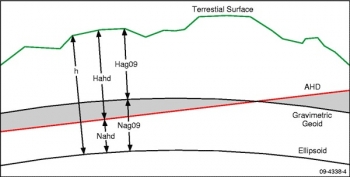
Survey Preparation (2)
Published comparisons of AHD with the latest available gravimetric geoid model - AUSGeoid98 - revealed an RMS agreement of up to +/- 0.364m across Australia's continent. As the project was located in a remote region of central Queensland with little previous survey undertakings, it was impossible to remotely ascertain whether the AUSgeoid98 model would be suitably accurate for construction use.
The first step of the survey action plan involved monitoring 140 primary control marks along with another 12 marks laterally offset from the alignment footprint. Static GPS measurements were triangulated along the entire length of the footprint and the results post-processed and analysed. These early measurements supported the theory that the MGA94 horizontal framework and AUSgeoid98 vertical model were reasonably accurate in this region with early survey measurements achieving acceptable results.
The next step was to digitally level the entire construction footprint. In preparation for the digital levelling, over 800 control marks were placed along the alignment. These would serve as change points for the level runs and would later be positioned to create a secondary control network.
Over the following weeks, both the primary and secondary marks were digitally levelled along the 169 km of railway formation. Levels acquired on the primary control marks from both digital levelling and static GPS were again compared to provide a more complete confirmation of the use of the AUSgeoid98 model as a vertical datum for the project.
In order to complete the secondary control network, Real Time Kinematic (RTK) GPS measurements were taken on all 800+ marks so as to determine their horizontal position. These additional 800+ RTK GPS levels were also compiled and compared against the digital level runs. The results provided a final opportunity to confirm the acceptance of the AUSgeoid98 model as the project's vertical datum.
At the completion of the digital levelling and RTK measurements across the entire survey control network spanning the project footprint, the survey team confirmed that using the MGA94 / AUSgeoid98 coordinate frameworks was suitable for the CoalConnect project without the need to create isolated planes along the alignment.
With the control network accurately positioned, the project was now equipped with both a satellite-based and total station based positioning solution that could be confidently extended or recovered at any time.
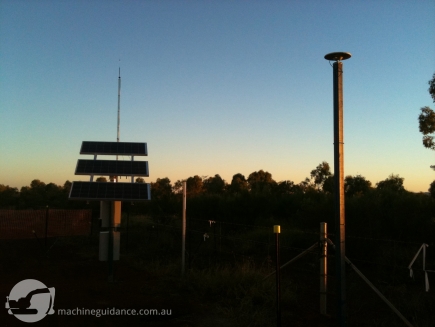
GPS Base Stations
With the coordinate framework in place and GPS accuracy confirmed across the entire site, it was time to establish a network of GPS base station correction deliveries. Unfortunately CDMA coverage was poor in this area of remote central Queensland so reliable communications via mobile internet or Wi-Fi were unachievable. With such massive distances, 900MHz radio solutions were also deemed impractical. The obvious solution was the tried and tested 450MHz radio solution even though this was at the expense of two-way communication possibilities.
Even with a 450MHz radio solution, the project footprint was identified as being much too large for a single frequency solution. As such, Sitech Construction Systems were contracted to perform a radio strength survey in order to determine the most suitable GPS radio hardware locations and ensure the most efficient alignment coverage. Based on the radio survey results and the required construction locations, a total of five base station and seven radio repeater locations were identified to guarantee GPS correction coverage.
As part of ensuring the continued availability of GPS positioning solutions, it was determined that this hardware should be self-sufficient. Permanent masts were erected in each location for mounting of the GPS receiver and radio hardware. A separate mast was also erected to house three solar panels along with lockable strong boxes that could securely house the GPS base and radio hardware. Solar panels calculations enabled the continuous power charging of two large deep-cell in-line batteries. These batteries were then wired to a multi channel timer. During construction hours the timer directed power to the Trimble SPS851 receiver and the HPB450 external radio transmitting a CMRx satellite correction message at 35 watts with approx 15 watt gain through the radio antenna. At night, the timer would switch the transmitting radio off and divert all power to the receiver so as to charge the receivers internal battery. Power output calculations suggested that the solar panel setup could maintain power to the hardware even after five days of no sun. This would ensure the continued GPS availability even during periods of rostered survey breaks.
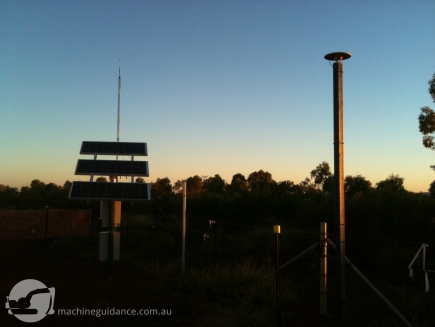
SPARE

SPARE
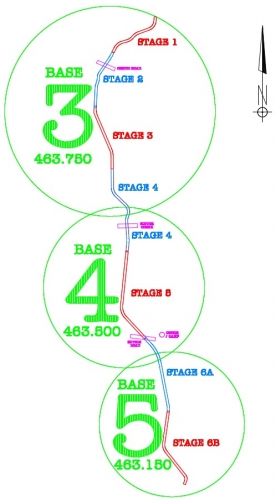
Design Models

SPARE

Machine Guided Construction Begins

Severe Weather Delays
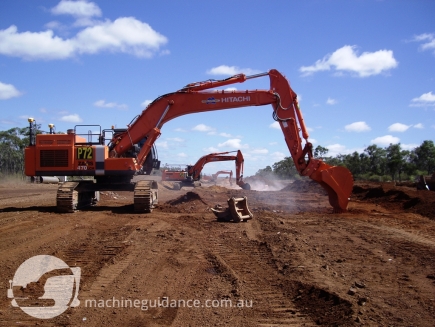
Construction Ramps Up

Reduced Survey Requirements

Additional Machine Control Benefits
The biggest operational advantages to CoalConnect's use of machine guided construction were:
- the ability to easily accelerate construction progress without the need for lengthy survey set-out delays; and
- the saving of hundreds of thousands of man-hours by reducing the project's earthwork survey requirements and eliminating the need for construction grade checkers.
The use of machine guided construction also directly and/or indirectly contributed to the acceleration of the construction program through the additional benefits outlined below.

Increased Safety
Increased Safety
One of the largest safety risks identified on the CoalConnect site was personnel working on the ground in proximity to heavy machinery. CoalConnect's use of machine control for earthworks operations eliminated this risk by removing the CoalConnect construction program tightened and heavy vehicle movements were dramatically increased.
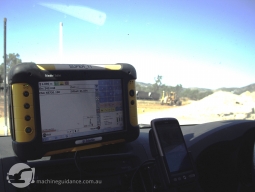
Improved Accuracy
Improved Accuracy
The challenge of moving earth to tolerance of millimetres is daunting to say the least. Traditional construction methods that use survey stakes and string lines sometimes do this well, but are always time consuming and prone to error. However, CoalConnect eliminated these old tools from the construction site by placing job design reference directly inside the machine cab. Constructed results were easily checked by 3D-machine operators and GPS supervisor reference systems, saving the time and costs that would have been required for any construction rework. CoalConnect earthworks fleets were able to confidently move on to the next work site knowing that the survey conformance checks that were to follow would prove that the constructed results were within the required tolerance.

Design Updates
Design Updates
On a traditional construction site, any change in an office-based design is not reflected in the field until the survey crews have the opportunity to replace the set-out stakes. This is often a time consuming process and consequently there is a risk of the intended design change reaching the field too late for construction works. However, on the CoalConnect project the design changes were electronically updated into the field machinery. In a similar way as they are distributed to the surveyors, any design updates were passed on to 3D machinery in a time-effective manner.

Unplanned Works
Unplanned Works
The reality of any earthworks construction is that things do not always go to plan. At CoalConnect, unpredicted delays sometimes resulted in construction crews prematurely moving operations to a new area for a variety of unforeseen reasons. As these works were unplanned, a traditionally surveyed project would suffer delays while waiting for survey set-out, resulting in significant downtime for construction fleets. However, with the machine guided construction employed at CoalConnect, all the design information was immediately available to the earthworks fleets and supervisors. Unplanned works could be commenced and completed without the delay of waiting for traditional survey field set-out.
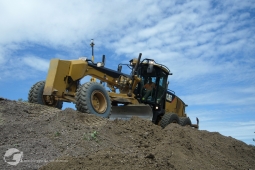
Increased Job Satisfaction
Increased Job Satisfaction
Another benefit that arose from the utilisation of machine control technologies at CoalConnect was an increase in job satisfaction. As field staff and machine control operators had more involvement with the design and a better understanding of the project as a whole, they took more pride and ownership of their works. Similarly, as survey crews were not required to perform the repetitive and sometimes soul-destroying task of pegging and re-pegging the design features, they too were able to move on to more satisfying tasks and take on more responsibilities. Using machine guided construction at CoalConnect made for more informed and valuable employees and also reduced the costly and timely exercise of replacing staff.

Construction Results
The use of machine control by CoalConnect can be described as no less than an absolute success. Despite the massive distances involved and the remoteness of the project's location, the position techniques proved reliable and accurate. Employing the use of machine guided construction allowed the CoalConnect construction team to not only maintain but easily accelerate bulk earthworks construction when required. A total of 3.16 million m3 of bulk earthworks over the three construction sites was successfully moved without the need for a single earthworks survey stake or string line.
Despite some severe weather events that included two cyclones and significant flooding, CoalConnect completed all works on time and delivered the completed railway alignment to allow QR National to officially open the new rail line as promised at the end of 2011.

Conclusion
There is no doubt that the successful implementation and extensive use of machine control technologies helped ensure the success of the CoalConnect project. With significant forethought and preparation at the commencement of works, machine control positioning solutions were immediately available for extensive field use. This allowed construction programming to be ramped up with relative ease when the need arose.
The numerous and significant operational benefits achieved by using machine control technologies were so effective that the CoalConnect project had no hesitation to embrace its use and become the largest machine control earthmoving project in the Southern Hemisphere.

Return to Articles Menu


